Elephantopus carolinianus Raeusch.
Carolina Elephant's Foot

Native
CC = 3
CW = 3
MOC = 56
© DETenaglia
Elephantopus carolinianus Raeusch.Carolina Elephant's Foot | |
 |
Native CC = 3 CW = 3 MOC = 56 |
© DETenaglia |
|
Family - Asteraceae/Vernonieae Habit - Perennial forb with a relatively stout, spreading, somewhat rhizomatous rootstock. Stems - Ascending to erect, to 1 m, sometimes multiple from a spreading base, unbranched or branched toward the tip, moderately hairy, with uneven hirsute pubescence near the nodes, but often becoming nearly glabrous toward the tip at flowering.
Leaves - Basal and alternate, simple, sessile or with a short, indistinct petiole, the basal leaves sometimes absent at flowering. Stem leaves gradually reduced toward the stem tip, the blade 2-18 cm long, elliptic-obovate to ovate or lanceolate, tapered or narrowed to a bluntly or more commonly sharply pointed tip, usually long-tapered at the base, the margins shallowly scalloped or toothed, rarely nearly entire, the surfaces sparsely to moderately hairy.
Inflorescence - Terminal panicles, with primary heads grouped into dense clusters at the branch tips, each cluster of 3-20 heads subtended by 3 leaflike bracts, these 1-3 cm long, ovate-triangular, more or less folded lengthwise, overlapping, with cordate bases. Each primary head produces an array of florets appearing (from a distance) as a single round flower.
Heads - Discoid, sessile or nearly so, with 4 florets. Involucre 6-10 mm long, cylindrical, the bracts in 2 alternating series with the outer series about half as long as the inner one, narrowly elliptic to narrowly lanceolate, somewhat rounded dorsally, sparsely to moderately hairy and with minute, impressed resin glands toward the tip, membranous toward the margins, the central portion green, sometimes purplish-tinged toward the tip, the basal portion often pale or whitened. Flowers - Pappus of a single series of 5 flattened, narrow, awnlike scales, persistent at fruiting, these 4-5 mm long, tapered to bristlelike tips and gradually broadened toward the base, with minute, ascending barbs. Corollas 7-9 mm long, lilac to whitish, deeply and asymmetrically 5-lobed, 1 of the sinuses between the lobes deeper than the other 4. Lobes to 5 mm long, linear, glabrous. Stamens 5, adnate at base of corolla tube. Anthers connate around style, 2 mm long, exserted.
Fruits - Achenes (excluding the pappus) 3-4 mm long, narrowly oblong-obtriangular in outline, not flattened, with 8-10 relatively narrow ribs, hairy, light brown to brown.
Flowering - July - October. Habitat - Forests, streambanks, pastures, fields, roadsides. Origin - Native to the U.S. Lookalikes - None. Other info. - This plant is common in the lower third of Missouri, though it also occurs in most counties which border the Missouri River on the north. Beyond Missouri its range occupies a well-defined region encompassing the southeastern quadrant of the continental U.S. The is easy to identify in the field as no other species in Missouri resembles it. Although the flowers are classified as disk florets, they are highly atypical, being unusually deeply lobed, as well as irregularly zygomorphic rather than radially symmetric. The four florets within a head often group in such a way that the array appears roundish and radially symmetric. Their color ranges from pale purplish to white. The plant prefers shaded moist woods, but is also tolerant of disturbance and will grow in shaded pasture areas. Photographs taken in Vale, NC., 8-23-03 (DETenaglia); also at Holly Ridge Conservation Area, Stoddard County, MO, 8-22-2009, Onondaga Cave State Park, Crawford County, MO, 8-20-2014, and near Labadie, Franklin County, MO, 10-1-2020 (SRTurner). |